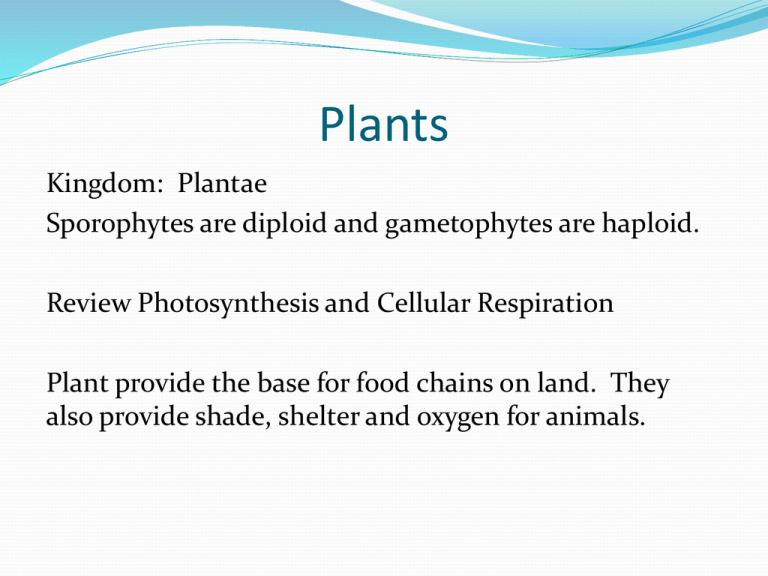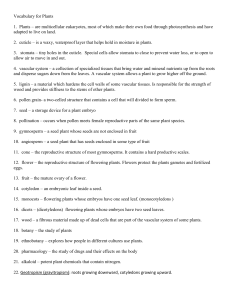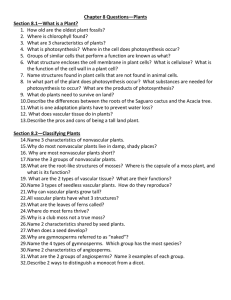Plants - Fort Bend ISD
advertisement

Plants Kingdom: Plantae Sporophytes are diploid and gametophytes are haploid. Review Photosynthesis and Cellular Respiration Plant provide the base for food chains on land. They also provide shade, shelter and oxygen for animals. Plant Life Cycle Plant life cycle has 2 alternating phases, a diploid (2N) phase and a haploid (N) phase. This is known as alternation of generations. Mitosis and meiosis alternate to produce the 2 types of reproductive cells which are the spores and gametes. Diploid (2N) phase is known as the sporophyte or spore producing plant. Haploid (N) phase is known as the gametophyte or gamete producing plant. Plant Life Cycle Plant spores are haploid (N) reproductive cells formed in the sporophyte plant by meiosis that can grow into new individuals is the gametophyte. Gamete is a reproductive cell that is produced by mitosis and fuses during fertilization with another gamete to produce a new individual, the diploid sporophyte. The earliest type of plants, mosses and ferns, required water to reproduce. Seed plants have evolve reproductive cycles can be carried out without water. Many plants have forms of vegetative or asexual reproduction. See Figure 22-2 Movement of H2O and Nutrients Plants takes up water and mineral through their roots and make food in their leaves. Specialized tissues carry water and nutrients upward from the soil and distribute the products of photosynthesis throughout the plant body. Simpler types of plants carry out these function by diffusion. Early Plants The first plant evolved from an organism much like the multicellular green algae living today. Land plants evolved from green algae. Early plants evolved structures that acquire, transport , and conserve water. Green algae have cell walls and photosynthetic pigments that are identical to those of plants. They have chlorophyll that captures energy from the sunlight during photosynthesis. Both use starch as a storage product Early Plants Most green algae have cell walls made of cellulose which is found in the cell wall of all plants. Evidence from genetic analysis points to an ancient species of green algae that is the common ancestor of all plants. Today the species would be classified as a member of the class Charophyceae. Today, charophyceans are common in freshwater habitats. Ancestral charophycean species may have grown in shallow water the dried out from time to time Early Plants Several important plant characteristics likely originated in the charophyceans are: 1. multicellular body, which lead to specialize cells and tissues 2. Cell division which produced cells with small channels in their walls 3. Reproduction where the sperm travels and fertilize an egg cell. True plants have multicellular embryos that remain attached to the female parent as they develop Early Plants The earliest plant fossil date to more than 450 million years ago. The first true plant grew on the edges of lakes and streams. They relied on droplets of water that bought sperm to eggs to produce the next generation of plants. Their structure was similar to moss, keeping low to the ground to retain moisture. Descendants were able to live in even drier areas Early Plants Fossils suggest the first true plant depended on water to complete their life cycles. The evolved of plants are more resistant to the drying sun. These plants are capable of conserving water and reproduce without water. Plant Adaptation for Land Algae is constantly surrounded by water which is needed for photosynthesis. The buoyancy of water supports the weight of most algae. Water provides the medium through which the sperm and spores can travel, allowing for reproduction and dispersal. Water prevents sperm, eggs, and the developing offspring from drying out. Plant Adaptation for Land The challenges of living on drier land acted as selective pressures for plants. Plants evolved adaptations that allowed them to retain moisture, transport water and other resources between plant parts, grow upright, and reproduce without free standing water. Plant Adaptation for Land Retaining Moisture The surfaces of plants are covered with a cuticle. A cuticle is a waxy, waterproof layer that helps hold in moisture. The are tiny holes in the cuticle called the stomata. Special cells that allow stomata to close to prevent water loss or to open to allow air to move in and out. Without the stomata the movement of air would be prevented by the cuticle. Transporting Resources Taller plants has better access to sunlight and CO2 from the air but they must get water and nutrients from the soil. A structure for moving the resources to different parts of the plant evolved in the form of a vascular system. Vascular system is specialized tissue that bring water and mineral nutrients up from the roots and disperse the sugar from the leaves. This system allows a plant to grow higher off the ground Plants Growing Upright Lignin a substance which hardens the cell wall of some vascular tissues. Lignin also strengthens wood and provides stiffness the stems of other plants. Lignin allows to retain their structure as they grow toward the sun. Reproducing on Land Eggs are fertilized within the tissue of the parent plant. The fertilized egg develops into an embryo. Some plants use raindrops or dew for reproduction. Other plants do not need free standing water for reproduction. These plants have adaptations that allow seed plants to reproduce. Pollen grain is a 2 celled structure that contain a cell that will divide to form a sperm. This pollen can be carried by the wind or animals to a female structure. Reproducing on Land Seed is a storage device for a plant embryo. The seed has a hard coat to protect it from drying wind and sunlight. When the conditions are right, the embryo can develop into an adult plant. Mutualism Mutualism in interaction between 2 species where both of the species are benefiting. Example: plant’s roots and fungi and bacteria The roots provide a habitat for the fungi and bacteria while the fungi and bacteria helps the plant to get nutrients from the soil. Flowering plants depends on the animal species for pollination or seed dispersal. The animals are fed by the pollen, nectar or fruit. Plant-Herbivore Interactions Plants have a variety or adaptations to keep animals from eating them. Plants have spines, thorns and chemical that act as pesticides against plant eating predators. The larvae of monarch butterflies, feed on milkweed species. Milkweed plants produce a chemical that makes the monarch larvae, adults , and even eggs taste bad to predators. The butterfly has a chemical protection as a result of eating the milkweed leaves during its development. Fruits and Seed Dispersal Biologically, a fruit is a flower’s ripen ovary which surrounds and protects the seed or seeds. Fleshy fruits are tasty food sources for animals, which digest the fruit tissue but not the seeds. Seeds pass through the animal and are deposited along with a supply of fecal fertilizer that helps during germination. Others may cling to wildlife or fibers that help spread seeds by wind. Flowers and Pollination Flowers have more efficient pollination than gymnosperms which relies on the wind for pollination. Animal pollinators transfer pollen from flower to flower in a very targeted way. Therefore; flowering plants pollinated by animals don’t need to produce nearly as much pollen as the plants that rely on wind to randomly transfer the pollen. Classifying Flowering Plants Flowering plants are classified into 2 groups based on 2 basic kinds of seed: seeds with one or two cotyledons Cotyledon is an embryonic leaf inside a seed. They are often called “seed leaves”. As embryo develop, the seed leaf may remain inside of the seed while others may break our of the seed and turn green. Monocot Monocots are flowering plants whose embryo has one seed leaf. Monocots plants have parallel veins in long, narrow leaves, like those in an iris of lily. Their flower parts occur in multiples of 3, and bundles of vascular tissues are scattered throughout the stem. Cereals plants such as corn, wheat, and rice. Also grasses, irises, and lilies. Dicots Dicots are flowering plants that have 2 seed leaves. Dicots have leaves with netlike veins. The flowers are in multiples of 4 or 5 and bundles of vascular tissue are arranged in rings. Deciduous trees that lose their leaves in the Fall are dicots. Peanuts are dicots. Herbaceous or Woody Stems Wood is a fibrous material made up of the vascular system of some plats. High concentration of lignin and cellulose make the cell walls of these cells thick and stiff. Vines have woody stems. Plants that do not produce wood, such as cucumbers and marigolds are called herbaceous plants. Three Types of Lifespans Annual – flowering plants mature from the seed, produce flowers, and die all in one year. Ex. Corn and lettuce Biennial – flowering plants that take 2 years to complete their life cycle. The first year they produce a short stem leaves that grow close to the ground and underground food reserves. During the second year, a taller stem, leaves, flowers, and seeds. Ex. Carrots Perennial- any flowering plant that lives for more than 2 years. Ex. Trees or die and grow back in the spring. Type of Plant Cells Plants cell have the same organelles as an animal cell plus cell wall, plastids and a large vacuole. Parenchyma – thin wall and water filled vacuole in the middle. Found throughout a plant. It stores starch, oils, and water for the plant. Photosynthesis takes place in the green chloroplast within the parenchyma cells in the leaves. Chloroplast and colorless plastids in parenchyma cells within roots and stem store starch. They divide their entire lives and helps with healing or regenerating new parts. Types of Plant Cells Collenchyma Cell has cell wall that range from thin to thick, providing support while allowing a plant to grow. Cells are found in younger tissue of leaves and shoots. The unique feature is the cells are flexible. The cells can elongate and still give the leaf structure. Sclerenchyma Cells – is the strongest type of cell. They have a 2nd cell wall which contains lignin making the cells very tough and durable. When the cell dies the dead cell disintegrate but the rigid cell wall is left behind as skeletal support of the water-conducting tissue for the plant. Sclerenchyma forms the fruit pit and the harder outer shell of nuts. Cells make linen and rope. Three Tissue Systems The plasmodesmata is the system that connects neighboring cells where cytoplasm that pass through openings in cell walls and connect living cells. The cells can share water nutrients, and chemical signals. Three Tissue Systems Dermal Tissue System – covers the outside of a plant and protect in a variety of ways. Dermal tissue epidermis) is made of live parenchyma cells in the nonwoody parts of the plants. Epidermal cells secrete a wax-coated substance that becomes the cuticle. Dermal tissue made of dead parenchyma cells makes up the outer bark of woody plants. Three Tissue Systems Ground Tissue System – makes up much of the inside of a plant. It provides support and stores materials in the roots and stems. The ground tissue in leaves is packed with chloroplast for photosynthesis. Ground tissue consist of all 3 simple tissue types: parenchyma tissue, collenchyma tissue, and sclerenchyma tissue. Parenchyma is the most common in ground tissue. Three Tissue Systems Vascular Tissue System transport water, minerals nutrients, and organic compounds (sugars) to all parts of the plant. The vascular system is made up of 2 networks of hollow tubes somewhat like our arteries and veins. Each network has a different type of vascular tissue to move different resources throughout the plant. Three Tissue Systems Xylem is the vascular system that carries water dissolved mineral nutrients up from the roots to the rest of the plant. Xylem contains other types of cells so it is called a complex tissue Phloem is the vascular tissue that carries the products of photosynthesis through the plant. The Vascular System Tracheid is a long narrow specialized cell in the xylem. Water can flow from cell to cell through openings in the thick wall. Vessel elements are specialized cells in xylem. They are shorter and wider than tracheids. When the vessel elements die, the cell wall disintegrates at both ends. The cell connect end to end and forms a long tube. The Vascular System Cohesion-tension theory –the physical properties of water allow the rise of water through the plant without metabolic energy. The theory is based strong attraction of the water molecule to one another and to other surfaces. The tendency for hydrogen bonds to form between water molecules creates a force called cohesion. Plant Kingdom Four groups based on 3 features: 1. Water conducting tissues 2. Seeds 3. Flowers 4. Reproductive structures The first plant evolved from a green algae living in fresh water not in the sea as once thought. Flowering plants have 235,000 species.






